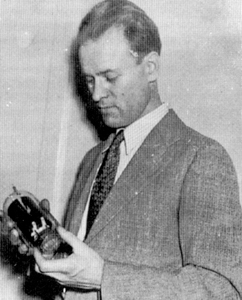STORY OF THE BOY WHO INVENTED TELEVISION
 The history segment of this Farnsworth story is taken from a book titled “Distant Vision,” written by Pem Farnsworth, because her eyewitness account is worth more than all the second and third hand accounts, including mine:
The history segment of this Farnsworth story is taken from a book titled “Distant Vision,” written by Pem Farnsworth, because her eyewitness account is worth more than all the second and third hand accounts, including mine:
In March 1954, Phil awoke at five in the morning with severe pains in his stomach. My frantic call to Dr. Hasewinkle, our family physician, brought him to our home very quickly. Suspecting a perforated ulcer, he had already called an ambulance. By the time the ambulance arrived, I had arranged to drop Kent off at a friend’s home and told Phil I would be at the hospital as soon as possible.
This was a miserable day, the streets were covered with ice, and to make matters worse, a freezing rain was falling. After dropping Kent off, I was traveling on a through street, when a car approaching from the right was unable to stop and plowed into the side of my car. The driver, owned the local funeral parlor, listened to my frantic story, quickly wrote down the necessary information, and told me not to worry; he would take care of everything. Fortunately, my car was still drivable.
When I finally reached the hospital, Dr. Justin Arata calmly informed me that he had just removed two-thirds of Phil’s stomach! I was furious to think they had performed such a radical operation without my approval! It took some time for Dr. Arata to explain why such a radical procedure had been necessary and to calm me down to the point where I could begin to accept it. Dr. Arata turned out to be a kind and considerate person, and I cannot remember whether I ever apologized for my hostility at our first meeting. After the operation, Phil experienced tremendous discomfort digesting food; and I felt for a long time the operation had been more radical than necessary. However, that’s Monday morning quarterbacking, and I’m sure it seemed the advisable procedure at the time… In September 1955, Phil received devastating news: Albert Einstein was dead at the age of 86. This was a crushing blow to Phil, as it came just when he was finalizing his math on fusion and getting it ready to share with Dr Einstein. Phil was very concerned that his ideas were so new only professor Einstein would understand them, and he had been counting on his concurrence when it came time to persuade others. With Einstein gone, Phil was even more on his own.
Phil continued to formalize his math and develop operative concepts for his fusion device, which by now had a name if not a specific shape. He called it the “Fusor.” In late 1955 his work took a great leap forward when he solved Poisson’s Equation for bi-polar charges (electrons and ions) in a spherical geometry. From this he coined the term “Poissor,” for the bright blue spot observed in the center of his structure-less vacuum tubes. Suffice it to say that the reactive core of the fusor began to take shape in the form of a hollow sphere.
In early January 1956 Rear Admiral Fredrick R. Furth, USN (“Just call me Fritz”), a former director of the Naval Research Laboratory, retired from the Navy at his own request while serving as Chief of Naval Research. Fritz joined the staff at Fort Wayne as assistant to the president of Farnsworth Electronics Company. Within a few months he was appointed vice president in charge of research and development. Having known Phil through their Navy contacts, he became extremely interested in Phil’s theory…
- Community Invited To Paint Rocks For Urban League Project - April 26, 2024
- The “Bad Guys” In Your Garden & What To Do About Them - April 26, 2024
- Why Voting In The Primary Election Matters - April 26, 2024


